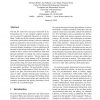Free Online Productivity Tools
i2Speak
i2Symbol
i2OCR
iTex2Img
iWeb2Print
iWeb2Shot
i2Type
iPdf2Split
iPdf2Merge
i2Bopomofo
i2Arabic
i2Style
i2Image
i2PDF
iLatex2Rtf
Sci2ools
CA
2002
IEEE
2002
IEEE
Representing and Parameterizing Agent Behaviors
The last few years have seen great maturation in understanding how to use computer graphics technology to portray 3D embodied characters or virtual humans. Unlike the off-line, animator-intensive methods used in the special effects industry, real-time embodied agents are expected to exist and interact with us “live.” They can be represent other people or function as autonomous helpers, teammates, or tutors enabling novel interactive educational and training applications. We should be able to interact and communicate with them through modalities we already use, such as language, facial expressions, and gesture. Various aspects and issues in real-time virtual humans will be discussed, including consistent parameterizations for gesture and facial actions using movement observation principles, and the representational basis for character believability, personality, and affect. We also describe a Parameterized Action Representation (PAR) that allows an agent to act, plan, and reason ab...
| Added | 14 Jul 2010 |
| Updated | 14 Jul 2010 |
| Type | Conference |
| Year | 2002 |
| Where | CA |
| Authors | Norman I. Badler, Jan M. Allbeck, Liwei Zhao, Meeran Byun |
Comments (0)

